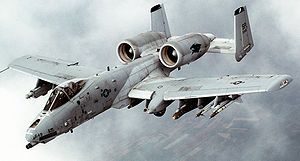A-10 Warthog
A-10 Thunderbolt II (Warthog)
The A-10 was designed for close support in low intensity conflicts during the Vietnam War, yet it came to be seen as a dedicated anti-armor platform by the early 1970s. Early before the A-10 came into production, however, the USAF held a fly-off between the Northrop YA-9 and the Fairchild Republic A-10. The A-10 was chosen and 707 A-10A's went into production. The Warthog, as it came to be known, was designed for high-survivability with a large-area wing, rear-mounted engines, and redundant and armored flight controls. A titanium covering surrounds both the cockpit and ammunition tank. As A-10's entered service in the USAF around 1977, and as vulnerability of the A-10 was questioned it was slowly withdrawn in favor of the F-16. Although the A-10 was never exported, it was redesignated OA-10 for the Forward Air Control role. The only difference between the A-10 and OA-10 is that the OA-10 only carries smoke rockets and AIM-9 Sidewinder AAMs for self-defense.

A-10 Thunderbolt II (Warthog) Achievements
- The A-10's survivability in close air support greatly exceeds that of previous air force aircraft.
- The A-10 was the first Air Force aircraft specially designed for close air support of ground forces.
